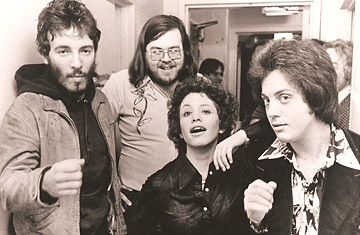
Singer-songwriter Janis Ian, center, poses with Bruce Springsteen, left, and Billy Joel, right.
Janis Ian's initiation into rock 'n' roll was early and dramatic. In 1966, at the age of 15, she recorded Society's Child, a song she'd written about an interracial romance. It raced up the charts and caused an immediate firestorm. Ian soon became pals with some of the era's greatest musical stars, including Janis Joplin and Jimi Hendrix. While she was fortunate not to meet their fates — both died of drug overdoses — Ian had her own tumultuous life. She attempted suicide, went broke, survived an abusive marriage, wrote and performed another megahit, At Seventeen, and became a lesbian activist. Ian, 57, recounts this and more in her new memoir, Society's Child (Tarcher/Penguin). TIME reached Ian at her home in Nashville:
How did you get your start in music?
I played for anybody and everybody from the time I started playing guitar, when I was 10 or 11. We were living in East Orange [, New Jersey], and I made friends with a bunch of student nurses, and I'd go over to their dormitory and play for them. I gave guitar lessons. I tried to join bands. My mom always said it was obvious that nothing was going to stop me.
How did your song Society's Child come about?
I started Society's Child on a bus in East Orange as I was going home from school. I saw a black and white couple sitting there and started thinking about it. I finished it sitting outside my guidance counselor's office. We moved to New York three or four months later and I started banging on doors. I was friends with [guitarist-vocalist] Gary Davis and his wife, and they took me down to the Gaslight Café and tried to convince the owner, Clarence Hood, to let me open for Gary. When he refused, Mrs. Davis told him that Gary wasn't feeling well and they had to cancel. So he let me open. And some guy literally ran backstage yelling, Kid, I'm going to make you a star.
There was a lot of controversy surrounding Society's Child. What happened when it came out?
In retrospect, I was very naive. My dad had said I was going to have problems over the song, but I really didn't think that I would. For me, it was just exciting because all of these stations in New York . . . were just all over the record. I thought the rest of the country would be, too. Then everybody started [sending] all this hate mail. To me it was just a song. I would hear Pete Seeger [discussing] the power of music to frighten people and to change people. Suddenly there I was in the middle of it.
Was it exciting? Was it frightening?
Both. I remember going into the supermarket, a Gristedes on 86th Street and Broadway, and it was playing in the background on the street. Somebody had a transistor radio, and they walked in with it. I thought, Oh my God, that's me. That's an amazing moment, the first time you hear yourself on radio. It's still thrilling. And it was scary because there were all these people screaming at me at concerts and people spitting at me on the street.
You were friends with some of the biggest stars of the era. Tell me about Janis Joplin.
I loved her. I think we fell in together because we had things in common. We both felt fat. We both had bad skin. We both felt like nothing we wore looked right. We were both outsiders, and she was very protective of me in a really nice way.
How about Jimi Hendrix?
Jimi was just gorgeous as a musician. Joplin was for shopping for clothes and hanging out and laughing, and Jimi was for playing. He was an amazing musician, a wonderfully openhearted player. He never had a problem letting other people shine.
